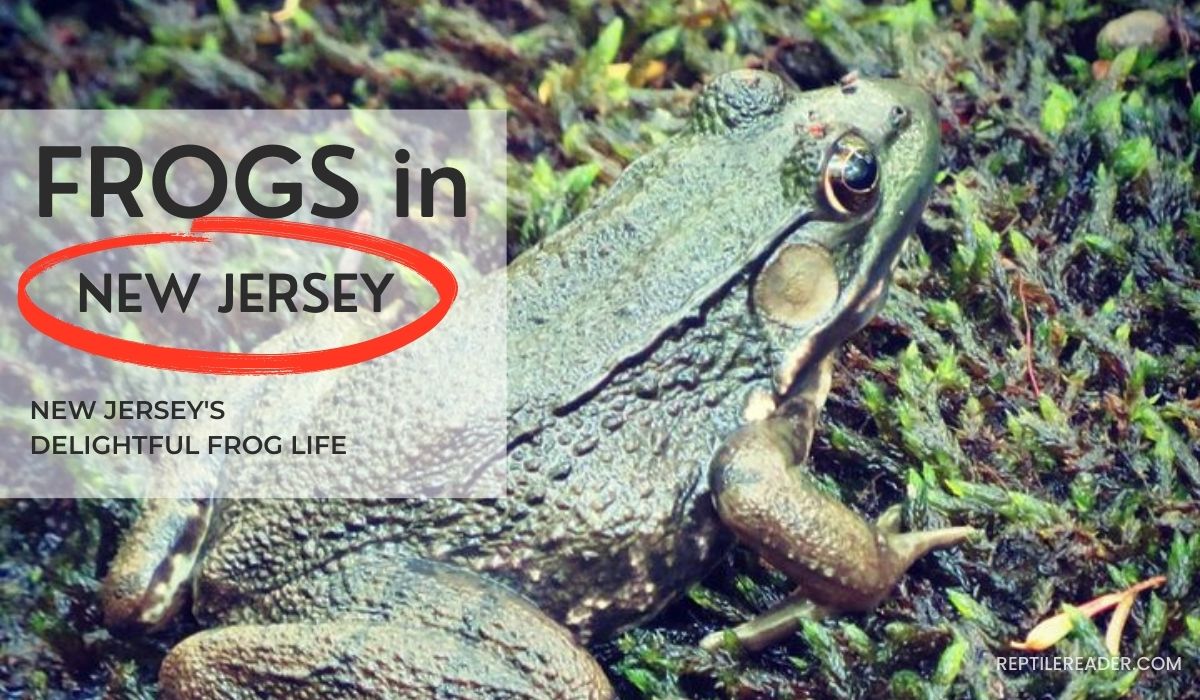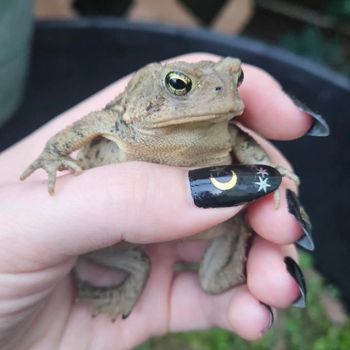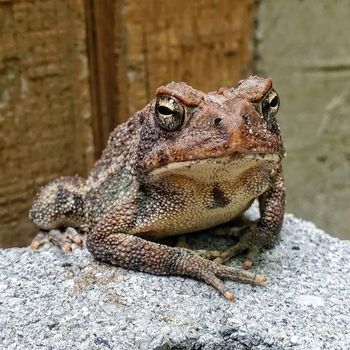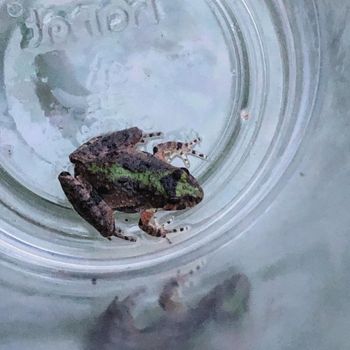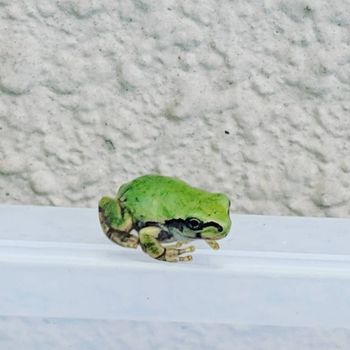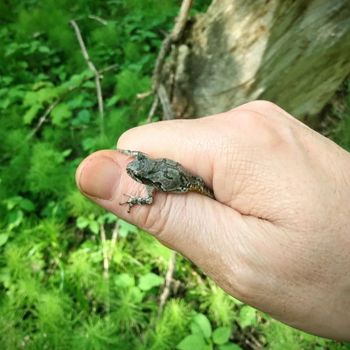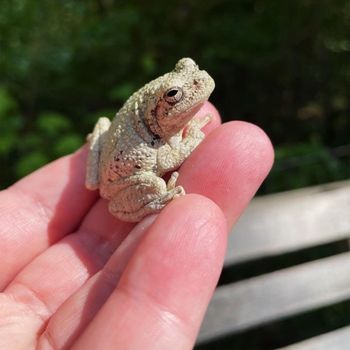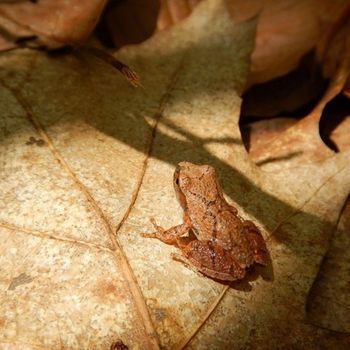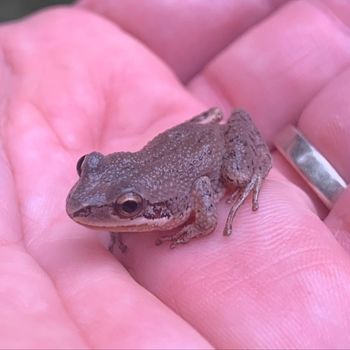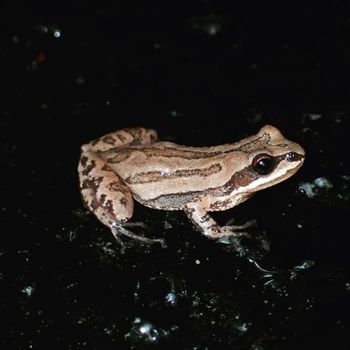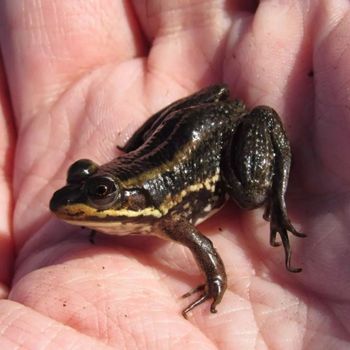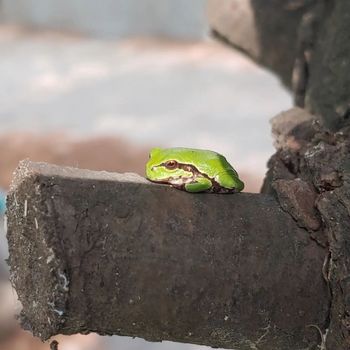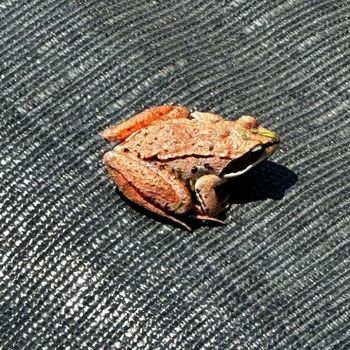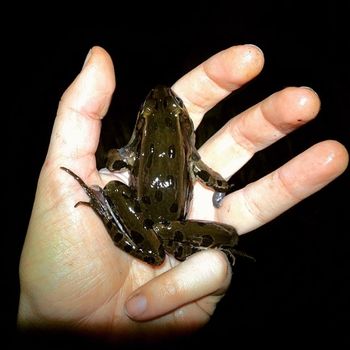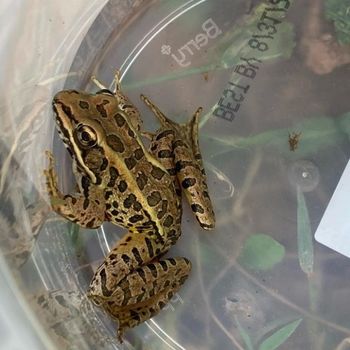Frogs in New Jersey: New Jersey’s Delightful Frog Life
Did you know that New Jersey is actually a froggy paradise? That’s right! Our lovely Garden State is home to an impressive variety of these fascinating creatures.
Let me tell you, we have 16 awesome species hopping around in our backyards and wetlands, just waiting to be discovered and appreciated.
So, let’s dive in, shall we? Prepare to be amazed as we take a closer look at the world of froggy inhabitants that call New Jersey their home.
| # | Name | Details | Image |
| 1 | Eastern Spadefoot Toad (Scaphiopus holbrookii) |
| 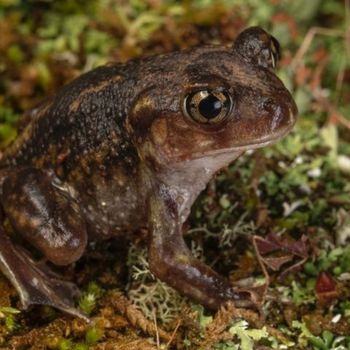 |
| 2 | American Toad (Anaxyrus americanus) |
|  |
| 3 | Fowler’s Toad (Anaxyrus fowleri) |
| 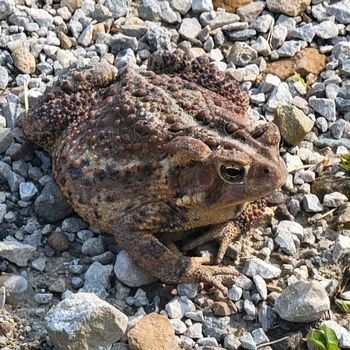 |
| 4 | Northern Cricket Frog (Acris crepitans) |
| 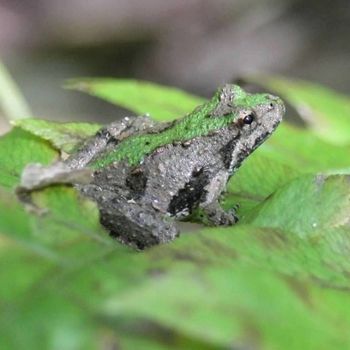 |
| 5 | Pine Barrens Tree frog (Hyla andersonii) |
| 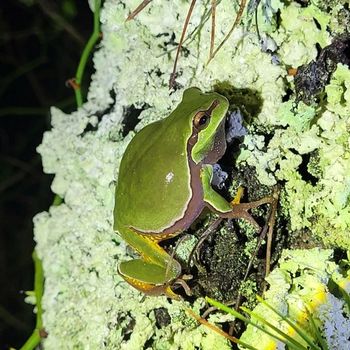 |
| 6 | Gray Tree Frog (Hyla versicolor) |
| 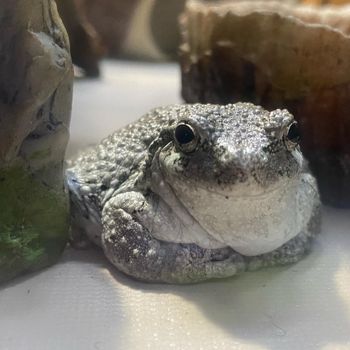 |
| 7 | Cope’s Gray Tree Frog (Hyla chrysoscelis) |
| 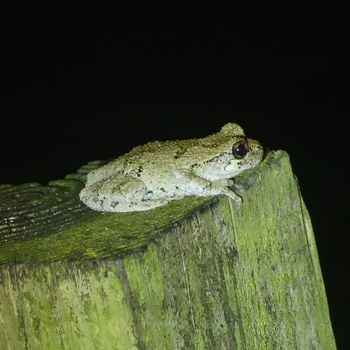 |
| 8 | Northern Spring Peeper (Pseudacris crucifer) |
| 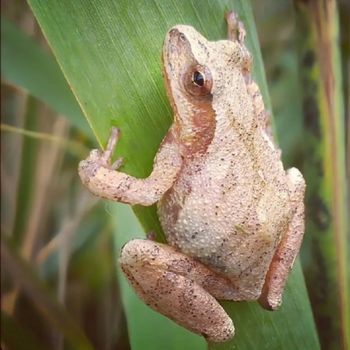 |
| 9 | Upland Chorus Frog (Pseudacris feriarum) |
| 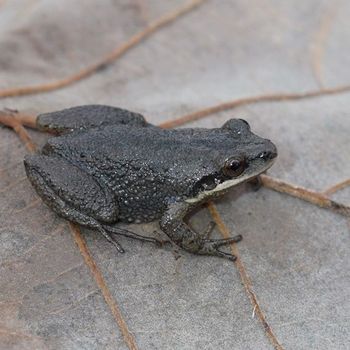 |
| 10 | New Jersey Chorus Frog (Pseudacris kalmi) |
| 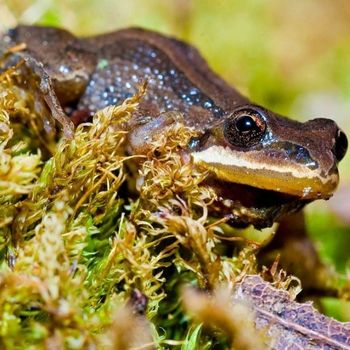 |
| 11 | American Bullfrog (Lithobates catesbeianus) |
| 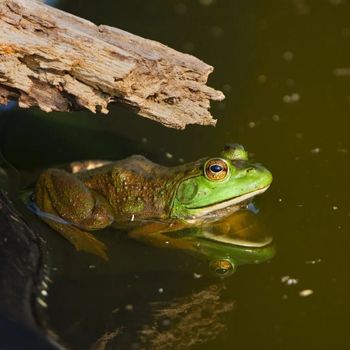 |
| 12 | Carpenter Frog (Lithobates virgatipes) |
| 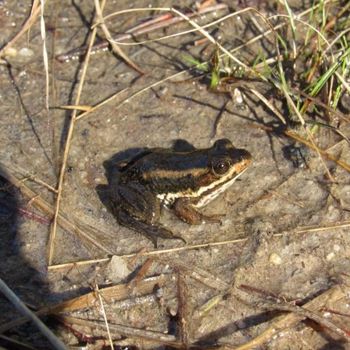 |
| 13 | Green Frog (Lithobates clamitans) |
| 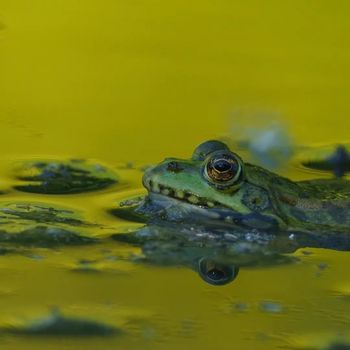 |
| 14 | Wood Frog (Rana sylvatica) |
| 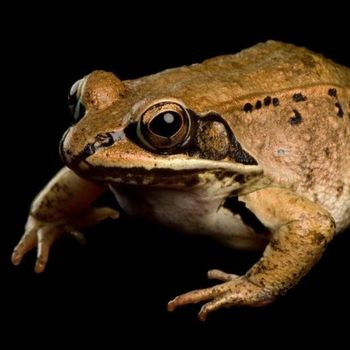 |
| 15 | Atlantic Coast Leopard Frog (Lithobates kauffeldi) |
| 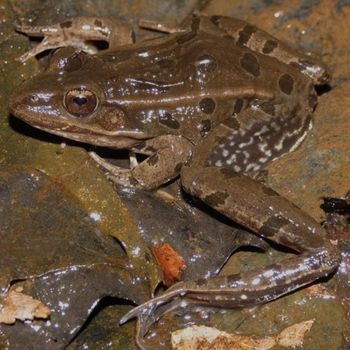 |
| 16 | Pickerel Frog (Lithobates palustris) |
| 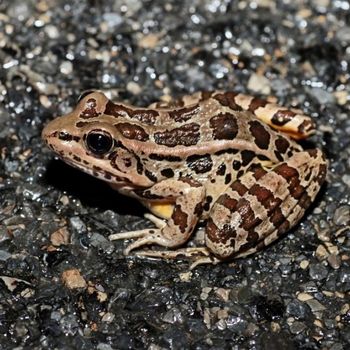 |
Are the Frog Species in Minnesota Similar to Those Found in New Jersey?
While both Minnesota and New Jersey have diverse frog populations, distinct regional differences set them apart. Minnesota’s mischievous frogs often adapt to colder climates with longer hibernation periods, unlike some species in New Jersey that thrive in more temperate environments. However, species like the spring peeper are found in both states.
16 Frog Species You Can Find in New Jersey
Get ready to dive deep into the lives of 16 incredible frog species that call New Jersey their home, showcasing their unique adaptations and remarkable behaviors.
1. Eastern Spadefoot Toad
- Scientific Name: Scaphiopus holbrookii
- Common Name: Eastern spadefoot toad
- Size: 1.8-3 inches (4.5-7.6 cm)
- Color & Pattern: Brown, gray, or green with dark markings, light stripes on back or sides
- Natural Habitat: Pine forests, sandhills, mixed woodlands, farmlands
- Geographic Range: Eastern united states, from southeastern massachusetts to central florida
- Diet: Insects, spiders, small invertebrates
- Reproduction: Breed in temporary ponds or pools, lay eggs in clusters
- Vocalization: Short, explosive call or snore-like sound
- Adaptation: Spade-like structures on hind feet for burrowing, can survive long periods of drought
- Conservation Status: Least concern
Found loitering in pine forests, sandhills, and mixed woodlands across the eastern United States, these little amphibians boast an impressive wardrobe, with colors ranging from brown, gray, or green, and adorned with dark markings and light stripes on their back or sides. Spanning a modest 1.8-3 inches, they’re quite the tiny critters.
Don’t let their size deceive you, though – they are fierce hunters. Chowing down on insects, spiders, and small invertebrates, Eastern Spadefoot Toads are vital to their ecosystem. Their keen senses might also pick up a short, explosive call or a snore-like sound, which are their vocalizations.
No ordinary toad, this species possesses spade-like structures on their hind feet for burrowing, allowing them to survive long periods of drought. Remarkably, they can rapidly breed after heavy rainfall, laying their eggs in clusters in temporary ponds or pools. With a conservation status of “Least Concern,” Eastern Spadefoot Toads have adapted well to their environments and continue to fascinate with their unique quirks.
2. American Toad
- Scientific Name: Anaxyrus americanus
- Common Name: American toad
- Size: 2-4.5 inches (5-11.4 cm)
- Color & Pattern: Varied brown, gray, or green with darker spots or patches
- Natural Habitat: Forests, fields, suburban areas
- Geographic Range: Eastern north america (canada to mexico)
- Diet: Insects, spiders, snails, small invertebrates
- Reproduction: Breeds in freshwater habitats, lays eggs attached to vegetation
- Vocalization: High-pitched trilling call by males during breeding
- Adaptation: Parotoid glands secrete toxin, can inflate themselves
- Conservation Status: Least concern
The delightful Anaxyrus americanus is commonly known as the American Toad. A medium-sized creature, stretching 2 to 4.5 inches (5-11.4 cm) in length, this charming amphibian sports a varied wardrobe of brown, gray, or green, adorned with darker spots or patches. Adapted to a range of habitats, including forests, fields, and suburban areas, it can be found croaking its way across eastern North America, from Canada to Mexico.
Armed with a voracious appetite, these intriguing l’il toads are the knights of the night, serving as important insect controllers. As nocturnal hunters, their diet consists of insects, spiders, snails, and other small invertebrates. When the time comes to multiply their forces, they breed in freshwater habitats and lay their eggs, spending their days singing a high-pitched, trilling serenade.
Fear not, for these cute-looking critters are packed with an array of impressive adaptations. Equipped with parotoid glands, they ooze a secret toxin when threatened, and can even inflate themselves to defy predators. Currently enjoying a stable environment, the conservation status of the American Toad is of “Least Concern.” Yet, their fascinating nighttime escapades make them an awe-inspiring addition to our ecosystem.
3. Fowler’s Toad
- Scientific Name: Anaxyrus fowleri
- Common Name: Fowler’s toad
- Size: 2-3 inches (5-7.6 cm)
- Color & Pattern: Gray, brown or green with dark spots and a pale stripe down the back
- Natural Habitat: Woodland areas, sandy coastal plains, grasslands, urban areas
- Geographic Range: Eastern united states and southeastern canada
- Diet: Insects, spiders, worms, small invertebrates
- Reproduction: Breeds in shallow freshwater habitats, lays eggs in strands attached to vegetation
- Vocalization: Short, nasal-like call by males during breeding
- Adaptation: Parotoid glands secrete toxin, can burrow to stay cool and moist
- Conservation Status: Least concern
Anaxyrus fowleri, commonly known as Fowler’s Toad, is a petite, nocturnal amphibian measuring only 2-3 inches in length. Boasting an earthy color palette of gray, brown, or green, this well-camouflaged toad sports dark spots and a pale stripe down its back, seamlessly blending into its woodland, coastal, and grassland habitats throughout Eastern United States and Southeastern Canada.
These adaptive, solitary creatures feast on insects, spiders, worms, and small invertebrates, employing their parotoid glands to secrete toxin as a brilliant defense mechanism. By digging burrows to stay cool and moist, Fowler’s Toad can adapt to various environments, even urban areas. Their survival strategy has paid off, with their conservation status ranked as “Least Concern.”
The males, distinguished by their nasal-like call, perform a short vocalization to court females during breeding season. Once the pair breeds in shallow freshwater, the female carefully lays her eggs in strands, attaching them to surrounding vegetation. With their intriguing behavioral patterns and stealthy appearance, Fowler’s Toad is undoubtedly an endearing and vital member of nature’s diverse network.
4. Northern Cricket Frog
- Scientific Name: Acris crepitans
- Common Name: Northern cricket frog
- Size: 0.6-1.5 inches (1.5-3.8 cm)
- Color & Pattern: Brown or green with dark spots or bands
- Natural Habitat: Shallow, permanent waters with vegetation
- Geographic Range: Eastern united states (minnesota to texas)
- Diet: Insects, spiders, small invertebrates
- Reproduction: Breeds in shallow waters, eggs attached to plants
- Vocalization: Distict chirping or clicking calls made by males during breeding season
- Adaptation: Powerful legs for jumping, freeze tolerance
- Conservation Status: Least concern
These tiny amphibians, ranging from 0.6 to 1.5 inches in length, display charming brown or green hues adorned with dark spots or bands. Hailing from the eastern United States, these little acrobats can be found amid shallow, permanent waters where vegetation thrives.
These remarkable frogs boast powerful legs, enabling them to leap up to six feet in a single jump! Northern Cricket Frogs primarily feast on insects, spiders, and small invertebrates. During breeding season, the males serenade their mates with distinct chirping or clicking calls, laying their eggs in shallow waters attached to various plants.
With a conservation status of Least Concern, the Northern Cricket Frog is a thriving species. One of their most fascinating traits is their incredible freeze tolerance, making them well-adapted to their environment. With such unique features, the Northern Cricket Frog is undoubtedly one of nature’s captivating wonders.
5. Pine Barrens Tree frog
- Scientific Name: Hyla andersonii
- Common Name: Pine barrens tree frog
- Size: 1.5-2 inches (3.8-5.1 cm)
- Color & Pattern: Green with a lavender stripe and a white belly
- Natural Habitat: Acidic wetlands, primarily associated with sphagnum moss
- Geographic Range: Eastern united states (new jersey, north carolina, south carolina, florida)
- Diet: Insects, spiders, small invertebrates
- Reproduction: Breeds in shallow ponds or wetlands; lays eggs attached to vegetation
- Vocalization: Males produce a nasal, quack-like call during breeding season
- Adaptation: Specialized toe pads for climbing, skin secretions to deter predators
- Conservation Status: Near threatened
With a mere size of 1.5-2 inches, these small creatures inhabit acidic wetlands, primarily amongst delicate sphagnum moss. You can find them across the eastern United States, from the forests of New Jersey to the swamps of Florida.
These tiny acrobats are insectivores by nature, artfully capturing insects, spiders, and small invertebrates for sustenance. In terms of reproduction, they breed in shallow ponds and wetlands, where they lay their eggs carefully attached to vegetation. The males are quite vocal during the breeding season, producing a distinctive nasal, quack-like call, irresistible to females.
Sadly, the Pine Barrens Tree Frog is now classified as near threatened. Their keen sensitivity to environmental changes makes them excellent indicator species for the health of their habitat. Fortunately, they possess unique adaptations, featuring specialized toe pads for climbing and skin secretions to deter predators. With our continued conservation efforts, these fascinating, elusive creatures will persist and thrive in our ever-changing world.
6. Gray Tree Frog
- Scientific Name: Hyla versicolor
- Common Name: Gray tree frog
- Size: 1.1-2 inches (3-5 cm)
- Color & Pattern: Gray, brown, or green with irregular markings, white spots under eyes
- Natural Habitat: Deciduous forests, shrubby areas, swamps, meadows
- Geographic Range: Eastern north america (canada to texas)
- Diet: Insects, spiders, small invertebrates
- Reproduction: Breeds in temporary and permanent freshwater habitats, lays eggs on floating plants
- Vocalization: Males produce musical trills during breeding
- Adaptation: Ability to change color, sticky toe pads for climbing
- Conservation Status: Least concern
Hidden within the deciduous forests, swamps, and meadows of eastern North America lies the elusive Hyla versicolor, a remarkably adaptable frog commonly known as the Gray Tree Frog. Gracefully climbing through their habitats with their sticky toe pads, these frogs exhibit an artistic mastery of disguise, changing from gray to brown or green, adorned with irregular markings and mysterious white spots concealing their bright eyes.
Spanning a petite 1.1-2 inches in size, Gray Tree Frogs feast daintily on insects, spiders, and small invertebrates. When it’s time to reproduce, they seek out temporary and permanent freshwater habitats, laying their precious eggs on floating plants. As males serenade their partners with musical trills, their unique adaptations ensure their survival amongst both the branches and the underbrush.
Braving harsh winters and freeze-tolerant, these adaptable creatures prove that beauty and nature’s artistry flourish even in the depths of adversity. Their skill and resilience has thankfully kept them far from the brink of extinction, a delightful testament to the magnificent wonders of the natural world.
7. Cope’s Gray Tree Frog
- Scientific Name: Hyla chrysoscelis
- Common Name: Cope’s gray tree frog
- Size: 1.0-2.0 inches (2.5-5.1 cm)
- Color & Pattern: Gray, green or brown with darker spots or patches, white underside
- Natural Habitat: Forests, swamps, wooded areas
- Geographic Range: Eastern united states and southeastern canada
- Diet: Insects, spiders, small invertebrates
- Reproduction: Breeds in freshwater habitats, lays eggs on water surface
- Vocalization: Short, rapid trills by males during breeding season
- Adaptation: Ability to change color, cling to surfaces, freeze-tolerance
- Conservation Status: Least concern
Perched high among the trees in the eastern United States and southeastern Canada, the enchanting Cope’s Gray Tree Frog thrives (Hyla chrysoscelis). With a petite frame of 1.0-2.0 inches (2.5-5.1cm), this shy creature can blend seamlessly into its surroundings, changing colors from gray, green, or brown with darker accents, while sporting a pristine white underside.
Feasting on insects, spiders, and other small invertebrates, the Cope’s Gray Tree Frog builds its life amid dense forests, swamps, and other wooded areas. As for reproduction, they embrace their love affair with water, breeding in freshwater habitats and laying their eggs on the surfaces of various bodies of water. This delicate creature takes part in a melodious symphony, with males contributing short, rapid trills during the breeding season.
Possessing an array of astounding adaptations, these frogs residing in New jersey can not only change color, but also cling to surfaces with ease and display an exceptional freeze-tolerance. In fact, they are known to survive even when partially frozen. With a conservation status of “least concern,” the enigmatic Cope’s Gray Tree Frog perseveres, occasionally venturing to the ground, but more often gracing the treetops with its whimsical charm.
8. Northern Spring Peeper
- Scientific Name: Pseudacris crucifer
- Common Name: Northern spring peeper
- Size: 0.75-1.5 inches (1.9-3.8 cm)
- Color & Pattern: Light brown, tan, or gray with an x-shaped marking on the back
- Natural Habitat: Woodlands, marshes, wet meadows
- Geographic Range: Eastern north america (canada to georgia)
- Diet: Small insects, spiders, ants
- Reproduction: Breeds in freshwater habitats, lays eggs singly or in clusters
- Vocalization: High-pitched ascending peep by males during breeding
- Adaptation: Freeze-tolerant, skin respirometer
- Conservation Status: Least concern
Boasting an enchanting color palette of light brown, tan, or gray, Pseudacris crucifer’s back proudly displays an unmistakable X-shaped marking that gives it an air of mystique. Spanning a petite 0.75 to 1.5 inches, this charming amphibian resides from the vast extents of Canada all the way down to Georgia.
In the hunt for its sustenance, the Northern Spring Peeper deftly seeks out small insects, spiders, and ants — notwithstanding its pint-sized stature. This talented little jumper does not shy away from the water, as it breeds and lays its eggs singly or in clusters within freshwater habitats. With the arrival of the breeding season, males serenade their partners with high-pitched ascending peeps, signifying their readiness to mate.
Such a captivating creature, the Northern Spring Peeper boasts the ability to change its color and survives due to its unique adaptation of a skin respirometer. Not only an intriguing find, but also a vital indicator of ecosystem health, this species is fortunately classified as being of “Least Concern.”
9. Upland Chorus Frog
- Scientific Name: Pseudacris feriarum
- Common Name: Upland chorus frog
- Size: 0.9-1.4 inches (2.3-3.5 cm)
- Color & Pattern: Green or brown with darker stripes or spots
- Natural Habitat: Woodlands, swamps, grasslands, marshes
- Geographic Range: Eastern united states (mississippi river valley to atlantic coast)
- Diet: Insects, spiders, small invertebrates
- Reproduction: Breeds in shallow freshwater habitats, lays eggs attached to vegetation
- Vocalization: Short, ascending trill by males during breeding
- Adaptation: Freeze-tolerant, can survive in temporary water bodies
- Conservation Status: Least concern
Measuring only 0.9-1.4 inches, these vibrant little creatures boast an array of green or brown hues adorned with darker stripes or spots, perfect for blending into their diverse habitats that range from woodlands to marshes across the Eastern United States.
These energetic jumpers have an appetite for insects, spiders, and other small invertebrates. When it comes to love, the Upland Chorus Frog exhibits true romanticism, as the males sing a short, ascending trill during breeding time in shallow freshwater habitats. Here, they lay their eggs attached to floating vegetation, creating a cozy cradle for their offspring.
Never backing down from a challenge, this frog’s adaptations are nothing short of remarkable. Their freeze-tolerant nature enables them to survive temporary water bodies, and they even have the intriguing ability to hybridize with other chorus frog species. With a conservation status of “Least Concern,” the Upland Chorus Frog remains a thriving and captivating member of the amphibian world.
10. New Jersey Chorus Frog
- Scientific Name: Pseudacris kalmi
- Common Name: New jersey chorus frog
- Size: 0.8-1.5 inches (2-3.8 cm)
- Color & Pattern: Greenish-brown with bold dark stripes on sides and back
- Natural Habitat: Grasslands, meadows, wetlands
- Geographic Range: Mid-atlantic states of united states (specifically new jersey)
- Diet: Insects, spiders, small invertebrates
- Reproduction: Breeds in freshwater habitats, lays eggs in small clusters attached to vegetation
- Vocalization: High-pitched, short trilling call by males during breeding
- Adaptation: Slender body, adapted for hiding in grassy habitats
- Conservation Status: Not evaluated by iucn; no official conservation status
Introducing the enigmatic New Jersey Chorus Frog (Pseudacris kalmi), a rare and elusive amphibian that roams the grasslands, meadows, and wetlands of the Mid-Atlantic states. Measuring a mere 0.8 to 1.5 inches, this diminutive greenish-brown beauty is uniquely adorned with bold, dark stripes that run down its sides and back, providing perfect camouflage in its grassy habitat.
Stealthily feasting on a diet of insects, spiders, and small invertebrates, this secretive species has adapted splendidly to its surroundings with its slender build, perfect for hiding among the vegetation. When it comes time to reproduce, the Chorus Frog serenades the evening air with high-pitched, short trilling calls performed by the males. The grand finale of this performance is the laying of eggs in small clusters, securely attached to aquatic plants in freshwater habitats.
While this enigmatic amphibian may be difficult to observe due to its secretive nature, there is no denying its fascinating charm. Despite not being evaluated by the IUCN and having no official conservation status, the Pseudacris kalmi stands as an intriguing mystery and an extraordinary resident of the New Jersey landscape.
11. American Bullfrog
- Scientific Name: Lithobates catesbeianus
- Common Name: American bullfrog
- Size: 3.5-6 inches (9-15 cm)
- Color & Pattern: Green to brown with dark spots and patterns
- Natural Habitat: Ponds, lakes, marshes, slow-moving streams
- Geographic Range: Eastern and central united states, canada, mexico, introduced worldwide
- Diet: Fish, crustaceans, insects, small mammals, birds, other amphibians
- Reproduction: Breeds in aquatic habitats, lays eggs in flat surfaces on water
- Vocalization: Deep, low-pitched calls by males during breeding
- Adaptation: Highly adaptable, strong legs for jumping and swimming
- Conservation Status: Least concern
Immerse yourself in the world of the American Bullfrog (Lithobates catesbeianus), a striking amphibian with a size ranging from 3.5 to 6 inches (9-15 cm). Adorned in a rich palette of green to brown, they exhibit dark spots and patterns which serve as excellent camouflage within their habitat. These aquatic creatures can leap and swim with grace and strength, due to their powerful legs.
Dwelling in the eastern and central United States, Canada, Mexico, and various regions around the world, they call ponds, lakes, marshes, and slow-moving streams their home. They satiate their hunger with a diverse diet of fish, crustaceans, insects, small mammals, birds, and other amphibians. The American Bullfrog is even known to be cannibalistic, predating on native species in introduced areas.
During breeding season, male Bullfrogs exclaim deep, low-pitched calls to attract mates, resulting in them laying their eggs in flat surfaces on the water for successful reproduction. Despite being a significant predator, their conservation status remains of least concern and they continue to thrive, showcasing their impressive adaptability. Delve deeper into the world of this fascinating amphibian, and uncover more about its unique quirks and captivating existence.
12. Carpenter Frog
- Scientific Name: Lithobates virgatipes
- Common Name: Carpenter frog
- Size: 1.5-2.5 inches (3.8-6.4 cm)
- Color & Pattern: Brown or dark tan with two light-colored stripes down each side
- Natural Habitat: Swamps, wet forests, and lowland streams
- Geographic Range: Coastal areas from south carolina to northeastern new jersey
- Diet: Insects, spiders, small invertebrates
- Reproduction: Breeds in shallow freshwater habitats, lays eggs in masses
- Vocalization: Males produce a series of short, sharp calls resembling hammering of a carpenter
- Adaptation: Adapted to life in water with intricate swimming and diving abilities
- Conservation Status: Not evaluated by iucn, but species is considered of least concern regionally
Meet the woodland artisan, the Carpenter Frog (Lithobates virgatipes)! This petite amphibian (1.5-2.5 inches) dons a clever camouflage of brown or dark tan with two bold stripes.
Like a siren of the swamp, it thrives in coastal wet forests from South Carolina to New Jersey. Chowing down on insects, spiders, and tiny invertebrates, it thrives underwater with a mastery of swimming and diving.
While not a conservation concern, its unique hammering calls and coastal habitat enchant all who encounter it in New jersey.
13. Green Frog
- Scientific Name: Lithobates clamitans
- Common Name: Green frog
- Size: 2.3-3.5 inches (5.8-8.9 cm)
- Color & Pattern: Dark green or olive green with small dark spots
- Natural Habitat: Ponds, marshes, lakeshores, slow-moving streams
- Geographic Range: Eastern united states and canada
- Diet: Aquatic insects, snails, crustaceans, small fishes
- Reproduction: Breeds in shallow freshwater habitats, lays eggs in clusters
- Vocalization: Deep, bass-like calls by males during breeding
- Adaptation: Highly aquatic, powerful hind legs for jumping and swimming
- Conservation Status: Least concern
Behold the vibrant Lithobates clamitans, better known to us earthlings as the Green Frog! Its striking, dark green or olive green hue, accented by tiny spots, easily captivates the eye – a stunning inhabitant of the ponds, marshes, lakeshores, and slow-moving streams across Eastern United States and Canada. This exquisite amphibian masters the art of camouflage with a size ranging from 2.3 to 3.5 inches (5.8-8.9cm).
As a natural-born gourmet, the Green Frog feasts on a delectable menu of aquatic insects, snails, crustaceans, and small fishes. Cunning and creative, it seeks out shallow freshwater habitats for breeding, laying clusters of eggs as a part of its ingenious reproduction cycle. And, oh, how they serenade! The males’ deep bass-like calls enchant during the breeding season, as their bright yellow vocal sacs visually delight.
Frogs that are designed to jump and swim with their powerful hind legs, these phenomenal creatures are highly aquatic by nature. Perhaps the most fascinating facts linger in their ability to magically regenerate lost limbs, forming an extraordinary evolutionary edge. Fear not for their future, as they are classified with a conservation status of “Least Concern.” Our enchanting Green Frog will continue to leap and swim, astonishing us for years to come.
14. Wood Frog
- Scientific Name: Rana sylvatica
- Common Name: Wood frog
- Size: 1.4-3.7 inches (3.5-7.6 cm)
- Color & Pattern: Tan or brown with dark mask around eyes and back leg stripe
- Natural Habitat: Woodlands, bogs, swamps
- Geographic Range: North america, from alaska to new england, and south to northern georgia
- Diet: Insects, spiders, worms, slugs, snails
- Reproduction: Breeds in freshwater habitats, lays eggs in clusters attached to vegetation
- Vocalization: Males make a duck-like quacking sound during breeding
- Adaptation: Ability to freeze and thaw as a means to survive cold conditions
- Conservation Status: Least concern
Meet the captivating Rana sylvatica, commonly known as the Wood Frog, a forest-dwelling amphibian with an exquisite flair for blending into its surroundings. Sporting a fashionable tan or brown, adorned with a dark mask around its eyes, and a sleek stripe on its back legs, this petite creature ranges from 1.4-3.7 inches in size (3.5-7.6 cm). Its range spans North America, from the bustling wilds of Alaska to New England, with southern settlers in northern Georgia.
A gourmand of small delicacies, the Wood Frog feasts on a varied menu consisting of insects, spiders, worms, slugs, and snails. Its breeding rituals take place in the serene freshwater habitats it calls home, laying its precious eggs in clusters that find attachment on submerged vegetation. The debonair males serenade potential mates with duck-like quacking during these amorous encounters.
The true pièce de résistance of this incredible species is their unparalleled ability to freeze and thaw, permitting survival in harsh, cold conditions. Amidst this extraordinary talent, the Wood Frog is not considered at risk with a conservation status deemed of least concern. The fascinating life of the Wood Frog unfolds with eggs hatching within mere weeks, showcasing their resilient nature and true wonder.
15. Atlantic Coast Leopard Frog
- Scientific Name: Lithobates kauffeldi
- Common Name: Atlantic coast leopard frog
- Size: 2-3.5 inches (5-8.9 cm)
- Color & Pattern: Green, brown, or gray with dark spots and light borders
- Natural Habitat: Marshes, wet meadows, swamps, coastal areas
- Geographic Range: Eastern united states (from connecticut to north carolina)
- Diet: Insects, spiders, small invertebrates
- Reproduction: Breeds in freshwater habitats, lays eggs in temporary or permanent water sources
- Vocalization: Guttural chuckling or snoring sound by males during breeding
- Adaptation: Well-developed legs for swimming and leaping, cryptic coloration for camouflage
- Conservation Status: Not evaluated
Hidden in the mysterious marshlands of the Eastern United States resides the enchanting Atlantic Coast Leopard Frog (Lithobates kauffeldi). Adorned in a majestic cloak of green, brown, or gray, these fascinating amphibians are embellished with dark spots and light borders, making them masters of camouflage. With a modest size of 2-3.5 inches, they frolic gracefully between wet meadows, swamps, and coastal areas stretching from Connecticut to North Carolina.
Agile hunters with a penchant for insects, spiders, and small invertebrates, these frogs wield their well-developed legs for astounding leaps and nimble swimming. In pursuit of love, the males serenade their mates with peculiar guttural chuckling or snoring sounds, a unique characteristic of this species. The lovers rendezvous in freshwater habitats where they lay their eggs in temporary or permanent water sources, ensuring the survival of their lineage.
The Atlantic Coast Leopard Frog is undeniably a resilient and adaptable species, boasting the impressive ability to endure even the harsh conditions of salt marshes. Surprisingly, this remarkable creature was only discovered in 2012, yet its conservation status remains unevaluated. As we continue to learn more about this elusive jewel of the marshlands, we must ensure its protection for future generations to cherish.
16. Pickerel Frog
- Scientific Name: Lithobates palustris
- Common Name: Pickerel frog
- Size: 1.5-3 inches (3.8-7.6 cm)
- Color & Pattern: Greenish-brown with parallel rows of dark square spots
- Natural Habitat: Woodlands, marshes, grassy wetlands, near streams and ponds
- Geographic Range: Eastern north america (canada to eastern u.s.)
- Diet: Various insects, spiders, and small invertebrates
- Reproduction: Breeds in freshwater habitats, lays egg masses on vegetation
- Vocalization: Low-pitched snore-like calls by males during breeding
- Adaptation: Produces skin secretions toxic to some predators, strong jumper
- Conservation Status: Least concern
Introducing the captivating Lithobates palustris, commonly known as the Pickerel Frog, a charming amphibian adorned with greenish-brown hues and striking parallel rows of dark square spots. Measuring 1.5-3 inches in size, this agile wonder thrives in the woodlands, marshes, and grassy wetlands of eastern North America, from Canada to the Eastern U.S., often found near streams and ponds.
An omnivorous creature, the Pickerel Frog dines on an array of insects, spiders, and small invertebrates. During reproduction, these remarkable frogs can be heard emitting low-pitched, snore-like calls as they breed in freshwater habitats and delicately lay their egg masses on surrounding vegetation. Boasting incredible adaptations, this frog not only produces skin secretions toxic to some predators, but is also a strong jumper.
Though currently of least concern in terms of their conservation status, the Pickerel Frog boasts a fascinating, and somewhat daunting, fact. Their toxins are harmful to other amphibians, which may lead them to devour smaller frog species. Despite this, the Lithobates palustris remains an intriguing and captivating creature of North America’s wetlands.
Nearby States:
Final Words
In summary, New Jersey boasts a remarkable array of 16 diverse frog species, displaying a kaleidoscope of colors, patterns, and unique adaptations. Embark on a fascinating journey through their habitats, appreciating their distinctive vocalizations, and uncover the secret lives of these magnificent amphibians that grace the state of New Jersey. From the vibrant green treefrog to the elusive carpenter frog, each species plays a vital role in their ecosystem, contributing to the state’s rich biodiversity. Just as frogs in West Virginia enchant locals with their croaks and calls, the frogs of New Jersey also captivate enthusiasts, offering a unique glimpse into the complex world of amphibians. Whether in wetlands or woodlands, these frogs are testament to the natural beauty and ecological importance of amphibian life.

